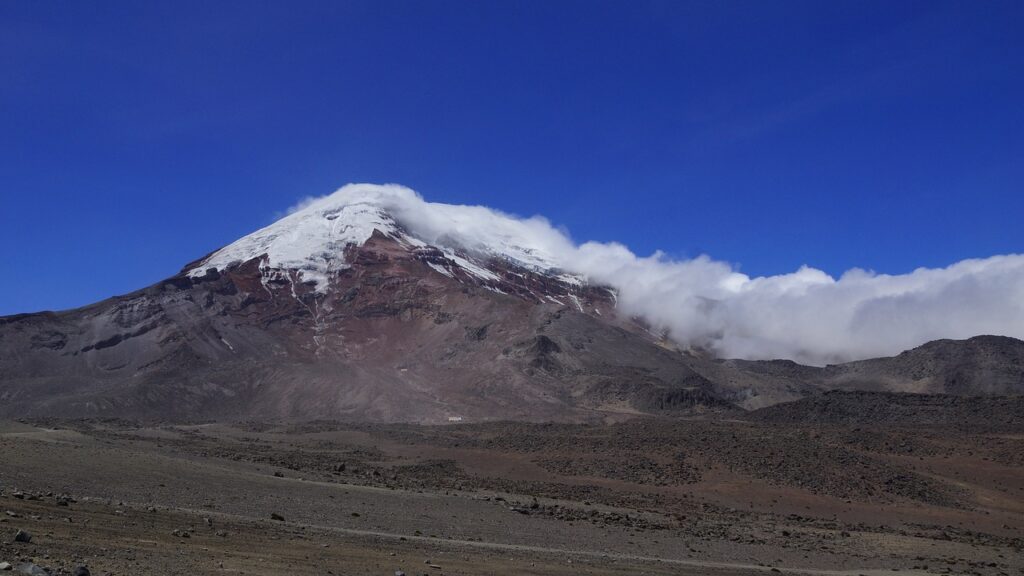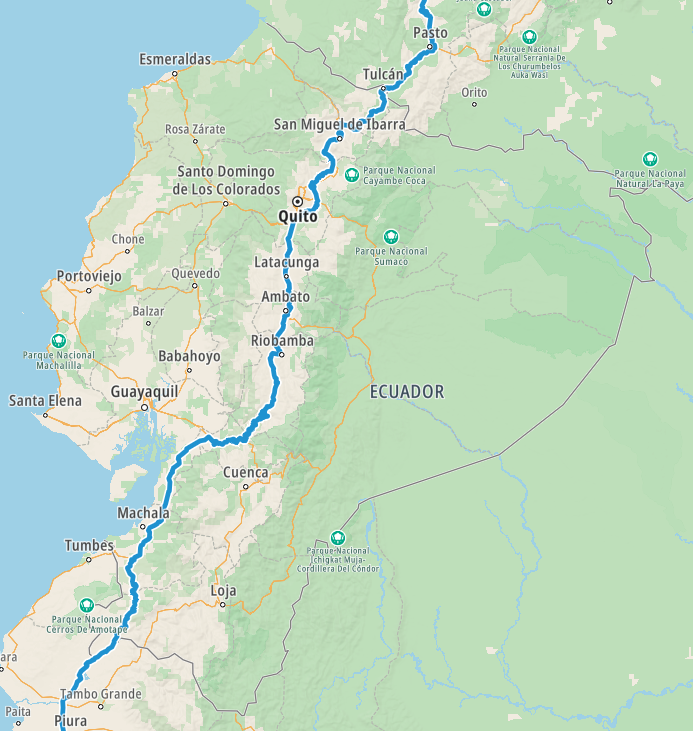Ecuador / República del Ecuador – Let’s explore here
What’s it like in Ecuador?
Ecuador is a country in South America, slightly larger than the United Kingdom. To the west lie the Andes mountains and the Pacific coast. To the east, the land becomes savannah and then jungle as it enters the Amazon rain forest. Within the Andes mountain range are many of Ecuador’s volcanoes and all of its snow-capped peaks, including one of the world’s highest active volcanoes, Mount Chimborazo, at 20,560 ft (6,268 m) above sea level. Mount Chimborazo is also the most distant point from the centre of the Earth on the Earth’s surface because of the ellipsoid shape of the planet.
Ecuador also owns the Galápagos Islands, an archipelago of volcanic islands in the Eastern Pacific, located about 560 miles (900 km) west of South America. The Galápagos are famous for their large number of endemic species, which were studied by Charles Darwin in the 1830s and inspired his theory of evolution by means of natural selection.
Ecuador’s population is around 17 million (2023) and its capital, Quito is home to almost 3 million. Quito is one of the highest capital cities in the world, at 9,350 ft (2,850 m) above sea level.


A bit about the history of Ecuador
Ecuador’s history is shaped by Indigenous cultures, Spanish colonisation, struggles for independence, and modern political and social changes.
Indigenous culture
Before Spanish arrival in the 16th century, Ecuador was inhabited by various Indigenous groups, including the Inca Empire, which briefly controlled the region. The northern part of present-day Ecuador was part of the Inca Empire, while the southern part was under the influence of other Indigenous cultures such as the Cañari and the Quitu.
Spanish colonisation
In 1533, Spanish conquistadors led by Francisco Pizarro arrived, and Ecuador became part of the Spanish Viceroyalty of Peru. The region’s economy was based on agriculture, mining, and the exploitation of Indigenous labor, and the Spanish imposed their culture, religion, and governance over the local populations.
Struggle for independence
Ecuador’s fight for independence from Spain began in the early 19th century, with the region becoming part of the wider struggle for independence across South America. After several battles, Ecuador declared independence from Spain on May 24, 1822, following victories by Simón Bolívar and Antonio José de Sucre in the Battle of Pichincha. Ecuador then became part of Gran Colombia, a union of several South American countries, but it became a separate republic in 1830 after Gran Colombia dissolved.
War
The 19th and early 20th centuries saw periods of political instability and territorial disputes, including a brief war with Peru over border issues. The country also faced challenges such as economic dependence on agriculture (especially cacao and bananas) and frequent changes in government.
Military rule
In the mid-20th century, Ecuador underwent social and political change, including land reforms and the growth of a more active civil society. However, the country also struggled with economic crises, political instability, and corruption, leading to periods of military rule.
Economic reform
In the 21st century, Ecuador experienced significant political shifts. In 2006, Rafael Correa was elected president and implemented policies focused on economic reforms, social programs, and increased state control over natural resources, particularly oil. His presidency brought both significant improvements in social indicators and controversial criticisms over authoritarian tendencies.
Ecuador has also faced environmental challenges, including the impact of oil extraction on the Amazon rainforest. The country’s political landscape has remained dynamic, with shifts between progressive and conservative governments. Today, Ecuador is a democratic republic, and despite its ongoing challenges, it has emerged as a significant player in South American politics and regional affairs.


Ecuador road trip
Our Ecuadorian road trip is part of a much larger South American road trip.
Map of our road trip through Ecuador.

Our current planned road trip in Ecuador takes us from Colombia towards the capital, Quito, before heading south on to Peru.
No doubt this Pan-South American route will change once we reach Ecuador, so that we can explore the country in more depth.
Hopefully our journey will improve our knowledge of this intriguing and beautiful country, and enable us to meet some interesting people. We’ll be updating this page at that time – don’t forget to check back
What’s it like to drive in Ecuador?
They drive on the right hand side of the road in Ecuador. Road conditions are poor in Ecuador, and driving standards are very poor.
Do you require an international driving permit in Ecuador?
We’ve created a dedicated page to driving abroad, which answers this question, and more, which you might find helpful.
Can you use your UK driving license when driving through Ecuador?
We’ve created a dedicated page to driving abroad, which answers this question, and more, which you might find helpful.
Do I need a carnet de passages to drive in Ecuador?
We’ve created a dedicated page to driving abroad, which answers this question, and more, which you might find helpful.
What currency do they use in Ecuador?
In Ecuador they use the US Dollar. Cash is widely used. The use of credit / debit cards is not widely accepted anywhere. Travellers cheques are not generally accepted. There are many ATMs in cities, although not all accept foreign issued cards.
You should make yourself aware of the amount that your bank charges you for using credit and debit cards abroad. Often credit cards are cheaper for purchasing items directly, and for withdrawing cash from ATMs.
What language do they speak in Ecuador?
They speak Spanish in Ecuador. English is not spoken widely outside of major cities.
What time zone is Ecuador in?
Remember, when you’re planning your next trip to take a look at what time zone it’s in.
Do I need a visa to visit Ecuador?
We’ve created a dedicated, more comprehensive page on visas, which you should find helpful. Check it out!
Is wild camping legal in Ecuador?
Yes, wild camping is fine in Ecuador, although make sure the land is not private.
What plug / socket type do they use in Ecuador?
In Ecuador they use plug / socket types A and B.


Health issues in Ecuador
Is it safe to drink water in Ecuador?
No, it is not safe to drink tap water in Ecuador. Bottled water is readily available throughout the country.
What vaccinations are required for Ecuador?
This NHS website is kept up to date with all relevant information on vaccinations in Ecuador.
Phones in Ecuador
What is the country calling code for Ecuador?
The country calling code for Ecuador is +593
What are the emergency phone numbers in Ecuador?
- The emergency number for police in Ecuador is: 911 / 101
- In Ecuador, the emergency number for ambulance is: 911 / 131
- The emergency number for fire in Ecuador is: 911 / 102
If you’ve got some useful info that you’d like to share, let us know!
And don’t forget to check out all the other pictures!
